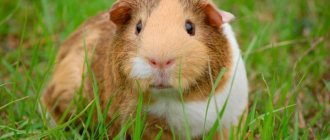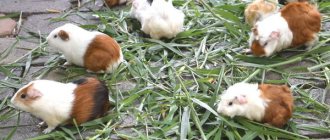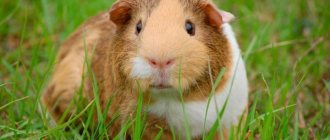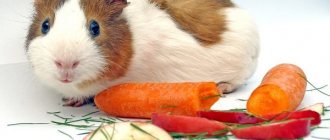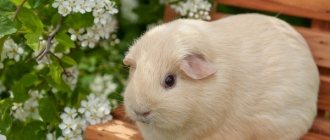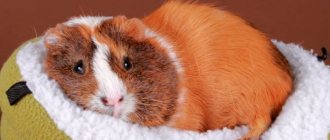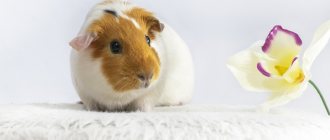- home
- Guinea pig
- Guinea pig health
02/07/2019 It is natural for guinea pigs to sneeze occasionally. As long as this process is not accompanied by unusual discharge, coughing, or watery eyes, there is no need to worry. But if the above or other alarming symptoms appear, the pig will have to provide first aid. Diseases in such small animals progress quickly, so do not delay a visit to the veterinarian.
Teaching proper manners
If the animal bites (not in the form of a show of love, but in real pain), you need to carefully place it back into the home.
During subsequent communication, you need to show maximum care. It is important to monitor which parts of the pet’s body are touched by the animal, and which, on the contrary, causes discomfort and causes protest on the part of the little pet.
Manifestations of friendliness in the behavior of a pet should be encouraged - give the animal treats. Gradually, the duration of the communication session with your pet should be increased.
The greatest result of taming is achievable while the animal is in childhood
That is why it is important, even in infancy, to accustom your pet to unpleasant procedures and processes necessary for care and maintaining hygiene. To minimize stress, you should follow simple rules:
- do not force the animal if it shows strong dissatisfaction with what is happening;
- eliminate external stimuli (sources of noise, etc.);
- do not disturb the animal during the adaptation period.
How to tame
Competent training is carried out like this:
- A finger is placed on the cage and removed if the pig shows aggression. The animal needs to say “no” - in a firm voice, but without raising the tone.
- The pig is given a treat, after which the finger is again applied to the bars of the cage. If your pet tries to bite again, you need to show him the gift, but you cannot give it away.
This process must be repeated every day until the result is achieved - the animal stops trying to “grab” the finger. Treats are the best motivation for a small rodent in any circumstances (reviews from owners are the main confirmation of this). The success of training will not be long in coming.
Bronchitis
Bronchitis usually occurs as a result of an untreated cold or infection. Most often, pets get sick in cold weather – winter and autumn. There are several types of bronchitis: hemorrhagic, purulent, catarrhal, etc. The disease causes severe coughing, high fever and sneezing. The symptoms are so severe that they quickly deplete the body and can lead to a heart attack and death.
Inexperienced owners are not recommended to self-treat for bronchitis. It is better to take your pet to the veterinarian, then provide him with rest and follow all instructions.
Colds in guinea pigs
— The guinea pig sits in one place all the time, coughs, breathes heavily, and has a runny nose.
— Guinea pigs, as a rule, often have pneumonia and pneumonia in spring and autumn. The disease is promoted by living in a damp, poorly ventilated area, drafts, inferior or poor quality food, devoid of vitamins, in particular C and A.
Microorganisms penetrate into a weakened body through the upper respiratory tract and cause inflammation in the lungs.
Pneumonia can be caused by diplococcus, a ball-shaped bacterium. It is not capable of moving, it does not form spores or capsules. Diplococci are usually located in pairs.
The second causative agent of the disease is the guinea pig pneumonia bacterium, which is an oval and somewhat elongated rod. Often these sticks are recognized in parallel rows. They also do not form spores, but unlike diplococci, they are motile.
The third causative agent of the disease is the guinea pig pneumonia bacillus, which also has the form of a rod. These sticks are sometimes arranged in chains of two to six. They are mobile, they have cilia, they form spores and capsules.
In guinea pigs, pneumonia occurs in two forms: acute and chronic.
In the acute form, signs of the disease increase quickly.
The guinea pig begins to eat poorly or does not touch food at all, and its temperature rises. The animal becomes inactive, its fur is disheveled. Visible mucous membranes are whitish-bluish, breathing is difficult and rapid.
Your guinea pig coughs frequently. If you put your ear to her side, to her chest, you can hear wheezing in her lungs.
In most cases, sick animals begin to have nasal discharge. Some people have swollen eyelids and mucopurulent discharge from the eyes.
The duration of the illness is three to four days. If your guinea pig is not treated, it will die.
The chronic form is characterized by less violent manifestations than the acute form, and the signs of the disease are less pronounced. With this form, on the twelfth to fifteenth day, the temperature, as a rule, is already normal. The guinea pigs regain their appetite and begin to gain weight.
Treatment. Guinea pigs do not tolerate antibiotics well, so it is best not to use them. A sick animal is given sulfonamide drugs daily: sulfadimezin or sulfazine at the rate of 0.1 grams per 1 kilogram of weight 3 times a day.
A guinea pig's recovery largely depends on when treatment is started and how it is administered. By the end of the first day, the animal’s temperature usually begins to drop. However, if treatment is interrupted after the first day or is not carried out vigorously enough, the temperature rises again and the animal’s general condition worsens. Therefore, sulfonamides should be used continuously for four to five days after the temperature drops.
A runny nose is treated by blowing streptocide powder into the nose.
The eyes are washed with a warm 2% solution of boric acid or holy water. The same or a 10 - 20% solution of sodium albucide, 0.1 - 0.25% solution of zinc sulfate is instilled into the eyes.
To make the cough go away faster, the guinea pig is given an infusion of coltsfoot herb, a decoction of nettle leaves, a quarter of a teaspoon 3 times a day.
As a general tonic, the guinea pig is given every day a 40% glucose solution with a 0.2% ascorbic acid solution, from 0.75 to 2.25 milliliters, depending on age, for six days. These drugs can also be given separately. Dose of ascorbic acid, tablets or powder, 50 milligrams per day.
It is necessary to improve the conditions for keeping and feeding the guinea pig, constantly give it food rich in vitamins - dandelion leaves, nettles, fresh or dried, carrots, beets, cabbage, green peas. In addition, every day a guinea pig needs ascorbic acid and vitamin C - 20 milligrams (for an adult animal, after recovery).
A guinea pig that has suffered from pneumonia, under unfavorable conditions of detention - cooling, inadequate feeding - again falls ill with pneumonia.
An approximate treatment plan for a sick pig
It is easy to understand that the specific treatment regimen will directly depend on what exactly is causing the sneezing:
- In case of allergies, you need to isolate your pet from the action of those factors and substances that caused this allergy. For mild allergies, this is quite enough, but in other situations, antihistamines will be required. We recommend using medications in drop form ( Zyrtec , for example), as they are much more convenient to dose. Medicines are given approximately once a day, the duration of treatment is about 5 days.
- Both in case of allergies and colds, it is very important to clean the animal’s nose from accumulated exudate and dried crusts. To do this, you need to rinse your nose. It is best to use warm saline solution for this purpose (it is completely safe) and the smallest baby syringe with a soft and long tip. At the end of the procedure, the animal’s nose is wiped dry and derinat (up to 3 times a day, drop by drop). The duration of treatment is about three days, but it can be extended if necessary.
- For colds, your pet is prescribed antibiotics. Rodents best tolerate drugs from the cephalosporin group. The dose, specific medicine and duration of use should only be calculated by a veterinarian!
Pneumonia in a guinea pig
Guinea pigs usually get pneumonia in the spring and autumn, when the weather changes frequently and sharply, there are temperature changes and dampness due to rain. Animals kept in premises with poor ventilation, drafts and dampness are at particular risk. An important factor that plays a role in the development of the disease is poor nutrition and lack of vitamins in the animal’s body. Sneezing and frequent coughing are among the very first symptoms of the disease. A more alarming symptom is chest wheezing - they indicate that pneumonia is at a serious stage and requires treatment under the supervision of a doctor. In addition to coughing and runny nose, guinea pigs experience swelling of the eyelids, mucous and purulent discharge from the eyes and nose.
A sick animal should be immediately isolated from other animals - pneumonia can be contagious.
- Diplococci. Bacteria that parasitize the lungs
- pneumonia bacteria,
- Pneumonia bacilli.
Pneumonia in guinea pigs can be both acute and chronic. The acute form of the disease proceeds quite quickly. The guinea pig experiences a decrease in immunity, an increase in temperature, the animal becomes lethargic, and greenish snot flows from its nose. Very often, pneumonia is accompanied by heavy and rapid breathing. The period of development of the disease is from three to five days. If the breeder does not take action and begin treatment, there is a high risk of death of the guinea pig. The chronic form of the disease is less noticeable and does not have such pronounced symptoms.
The chronic form of the disease can be recognized by frequent coughing and sneezing, and slight loss of appetite. At times the animal may become lethargic and sleepy, but its normal state returns quite quickly. Increased heart rate and breathing may occur.
Treatment of pneumonia
The success of treating the disease largely depends on the timely initiation of first aid. At the first signs, the guinea pig should be given Sulfazin or Sulfadimezin at the rate of 0.1 grams of the drug for each kilogram of the animal’s weight. The medicine is given three times a day. Streptocide powder will help with a runny nose, and to wash the eyes from purulent discharge, use a two percent solution of boric acid or a solution of sodium albucid 10% or 20%. A decoction of nettle leaves can help relieve coughs due to pneumonia. The decoction is given a quarter of a teaspoon three times a day.
In the treatment of pneumonia in guinea pigs, 2.5% Baytril, which is sold in any veterinary pharmacy, has proven itself well.
The drug is administered intramuscularly at the rate of 0.1 ml for each kilogram of animal weight. The injection period is up to ten days, depending on the form of the disease. The first good sign is a drop in the animal's temperature and the return of appetite.
Pneumonia is dangerous because it can cause a temporary improvement in health. Usually during this period, owners stop giving any medications, and soon the animal experiences a sharp deterioration in health: the temperature rises, an even more severe runny nose and cough appear, breathing becomes frequent and noisy. In frequent cases, a guinea pig may die due to exhaustion and overheating of the circulatory system. Therefore, it is recommended to continue giving the medication for four to five days after your health improves.
Along with medications, it is advisable to include more fresh greens in the animal’s diet. In summer - clover and dandelion leaves, in winter - sprouted grains, lettuce leaves. It's good to add more carrots, cabbage leaves and green peas. It is also advisable to give your guinea pig fifty milligrams of ascorbic acid per day.
How does it manifest?
Symptoms manifest differently for each person, but if any of the following occur, then this is a serious reason to consult a doctor.
The most common symptom is a skin rash resembling atopic dermatitis or urticaria. As a rule, it is accompanied by itching. Also, the skin may become excessively dry and even crack in the place where it came into contact with the allergen. There may also be simple redness: see similar symptoms in the photo on the right.
Other common manifestations of allergies include damage to the mucous membranes of the eyes or nose, as well as the respiratory system, expressed as follows:
- conjunctivitis of allergic etiology;
- rhinitis;
- reminiscent of the clinic of bronchial asthma, difficulty exhaling, shortness of breath, dry cough, wheezing and even attacks of suffocation.
“Hay fever,” as allergic rhinitis is also called, is similar in clinical picture to the usual infectious rhinitis: the same runny nose and sneezing, nasal congestion and itching. But, unlike the ever-increasing infectious rhinitis, allergic rhinitis occurs very quickly and is not accompanied by fever, headache and muscle pain.
Its main characteristic feature is literally streams from the nasal passages, often in combination with conjunctivitis. But the most striking feature: remove the suspected allergen - and the runny nose will stop (or resume when the irritant returns).
So, allergies can cause many questions if there are no guinea pigs in the house. And a person can start sneezing and coughing—seemingly for no reason—while visiting, after playing with the owner’s pet. This is a clear signal: there is a predisposition to “pig” allergies.
What to do if you suspect the cause of your allergy is the presence of a guinea pig in the apartment? To do this, you should contact an allergist and do special tests and blood tests that will help identify the culprit.
Common causes of death
Childbirth
Despite the fact that the guinea pig is considered the most prolific rodent, difficult situations associated with risk to life arise during pregnancy and after childbirth. Frequent occurrences are:
- Toxicosis. Occurs in the last week of pregnancy or in the first days of birth of the offspring. The reason is poor maintenance and care. It is impossible to help an animal with the development of toxicosis.
- The remaining placenta in the uterus.
- Complications during difficult childbirth. If there is obstruction of the birth canal or vaginal prolapse, immediate surgical intervention is required.
The death of offspring is observed if the female refuses to feed the babies.
Fight
Rumors about the superior fighting qualities of males in the same cage are exaggerated
Fighting for the female's attention, opponents can inflict injuries on each other, including deep lacerations. But there were no deaths
After anesthesia
During surgery, the dose of anesthesia for the rodent is carefully calculated. However, death can occur from advanced disease or due to pathology of the heart muscle.
Sudden death
Cases of unexpected death of a pet happen, like every living creature. The factors can be varied; an autopsy of the pet will help determine the cause.
Otitis media, causes itching and pain in the ears
Finally, another reason why your puppy is itching could be an ear infection if he is scratching the ear or head area. This disease is quite common in puppies, especially after bathing. This condition will cause your puppy to frantically scratch his ears, tilt his head toward the affected ear, and shake his head violently, among other symptoms. If you find this in your dog, you should take him to the vet so that he can give you the best treatment to make his ear infection heal as quickly as possible. Now you know several possible reasons and know that you should contact a specialist who will help your little and faithful companion in the best possible way.
Author of the article: Irene Juste. Veterinary assistant. I am a veterinarian technical assistant with various specializations in various areas such as felines and exotic animals. Currently, I have decided to pursue training in international trade and marketing, among other things, to be able to more easily fight for animals in this human world. I am a fighter and very active, I cannot stand aside. I have been a part of various volunteer activities so I always encourage respect for animals and promote their adoption.
If your pig is breathing heavily and wheezing
A cough does not always indicate diseases of the bronchopulmonary system. Sometimes this indicates cardiac pathology.
The animal needs quick help and advice from a specialist.
Symptoms of heart failure:
- The pig gasps for air;
- breathing heavily;
- periodic coughing;
- shortness of breath when moving;
- immobility develops;
- lethargy and apathy;
- paws are cool;
- fingers turn blue;
- coordination of movements is impaired;
- convulsions.
To stop heart and asthmatic attacks, you need to immediately drop 2 drops of Corvalol into the mouth and then let the animal smell cotton wool soaked in aroma oil. The animal is given an injection that includes aminophylline, dexamethasone, and furosemide.
They treat heart failure for a long time, maintaining vitality.
Heart drops are administered to the rodent using an insulin syringe with the needle removed.
An animal suffering from heart failure needs proper nutrition and good living conditions.
Common diseases and treatments
Not everyone knows what to do if their little pet sneezes, let's look at this issue in more detail. It is not difficult to monitor the health of guinea pigs; they have very good protection against diseases. However, if you have already got such a rodent, then you need to know about diseases that may still appear. The chances of your pet getting sick are minimal, but they do exist. If the rodent begins to behave differently, it is better to consult a veterinarian. Determining the disease in guinea pigs can be difficult, given that these animals lead a calm lifestyle and do not show symptoms of the disease.
If your guinea pig sneezes, you need to carefully monitor its behavior and record any changes. The fact is that this symptom may indicate the development of a dangerous disease, which may even threaten the life of the animal. If sneezing is one-time and not regular, then there is no reason to worry, because, like in humans, this can be a normal manifestation of life.
If a disease is detected, it is best to contact a veterinarian
The process of sneezing can occur regularly, then it makes sense to think about the presence of some pathology, in which case the little “patient” should be sent to the veterinarian. In a special institution, a specialist will examine and, if necessary, diagnose the animal; based on the data obtained, a diagnosis will be made. Next, the attending physician will draw up a detailed treatment plan, which will include taking medications and adjusting the diet.
Most often, diseases arise from viral infections. The most common are pseudotuberculosis, pestilence, and paralysis. When sick, rodents experience convulsions, their legs are lost, their fur becomes slimy, and the animal loses energy. At the same time, the rodent behaves nervously and its temperature rises. In such a situation, you need to immediately show the animal to a veterinarian. It is best to isolate the animal from other pigs, if any. Also, the patient should not be allowed to come into contact with other pets, as well as children. In general, diseases are not transmitted to people, but for children, the appearance of their friend can significantly affect their psycho-emotional state.
Diseases can be caused by microorganisms - ticks, fleas. The rodent begins to get scabies and hair falls out in places. If the disease is not treated for a long time, the animal may develop ulcers. Fleas and ticks can be removed yourself, following the rules of care for a sick animal. Special products for destroying harmful microorganisms can be purchased at pet stores.
Your pet may eat worse and be lethargic
Internal parasites are also pathogens. Various types of worms can live in the body of a guinea pig. It is very difficult to determine that an animal is sick. The pet may eat less food, and its general condition worsens. In this case, it is better not to resort to treatment, but to bring the rodent to a veterinary clinic.
Digestive tract diseases can occur due to poor nutrition. The animal should not be fed with food intended for cats or dogs; buy food that is 100% suitable for guinea pigs. The animal develops diarrhea, its general condition becomes worse, and its appetite worsens. The animal should be shown to the doctor.
When hypothermia occurs, your guinea pig may develop a runny nose or pneumonia. This condition is very dangerous for the pig: its temperature rises, loss of strength, interest in eating food decreases, a runny nose, and heavy breathing. The sick animal constantly lies down and does not pay attention to stimuli. The animal needs to be shown to a doctor urgently.
Hypothermia may cause your pet to get sick.
Disease Prevention
Many guinea pigs that develop respiratory problems are deficient in vitamin C. This can happen if you feed your pet kibble that is nearing its expiration date. Pay attention to the quality of the hay. The most valuable and useful will be hay made from May grass - it contains the maximum amount of vitamins. Hay from September grass is depleted of them. In hay that is stored, the amount of vitamins will also decrease. It is very important that your pet receives at least 50 mg of vitamin C per day.
Find out why guinea pigs squeak.
As for the prevention of diseases, you need to adhere to a number of rules in organizing the food and living of your pet:
- The food must be balanced for guinea pigs. Do not purchase food for rabbits or other rodents.
- Water should be clean, fresh and changed daily.
- Do not use sawdust from pine or other conifers.
- Do not place the cage in direct sunlight or in a draft. Place it away from noise, heavy foot traffic and large animals.
- The air temperature in the room should be from +18°C to +24°C. Avoid high humidity.
- Guinea pigs cannot get along with rabbits. Besides the fact that rabbits scare guinea pigs, they have different nutritional needs and the same diseases.
- Do not leave your pet alone with dogs or cats.
- Don't scare them and avoid dangerous games, including tossing.
- Monitor activity, appetite and water intake, hair quality and bowel movements, as changes in these may indicate illness.
Allergy
Allergies can develop to things that are familiar to the pet, with which it had previously been in easy contact:
- litter for a tray or cage;
- feed, including hay and vegetables;
- dust;
- wool;
- the material from which toys are made.
Predisposition to allergies is inherited. When sick, the animal often sneezes, itching, rash, and watery eyes appear. The pet scratches its face until bloody wounds form.
To get rid of allergy symptoms, you should identify the allergen and replace it with a safe option. For example, switch to feed or sawdust from another company. If the reaction is caused by dust, the room will have to be wet cleaned more often. After getting rid of the source of the allergic reaction, the animal is given antihistamines.
https://youtube.com/watch?v=YldCu1gQM3E
Cold
This pathological condition is not a disease as such, but rather will be a response to hypothermia. The disease manifests itself not only by sneezing, but also by:
- a slight increase in body temperature (the norm for pigs is 37.5-39.5 ° C),
- poor appetite
- worsening mood;
- ruffled coat;
- redness of the eyes, watery eyes;
- heavy or rapid breathing;
- the nose is clogged with thick contents, which is why the pig “grunts” or “sniffles”; in some cases, thick green or brownish mucus is released from the nasal openings.
If you don’t assess your pet’s health in time and leave everything to chance, then in most cases a cold will turn into bronchitis or, even worse, pneumonia. Therefore, at the first symptoms or suspicion of hypothermia, the mumps must be treated.
Therapy
First of all, it is necessary to clear the nasal passages of contents.
To do this, the nose is washed with saline or chlorcesidine (literally a drop in each passage). After that, the nasal mirror is wiped with a napkin and then derinat is instilled. Usually after it the animal sneezes heavily, which is the norm. It is better to bury it together: one holds the piglet by the body, and the second person tilts the pet’s head back and carefully, using a syringe without a needle, injects the medicine into each nostril (one drop into each).
To boost immunity, ascorbic acid is added to the water; by the way, it should generally be present in the animal’s diet every day. During illness, the dose is 1.5-2 ml of a 5% vitamin C solution per adult pig once a day.
Echinacea tincture (up to 5 drops per head), gamavit (1 ml in water) also contributes to rapid recovery - both of these drugs are considered immunomodulators.
Instead of water, you can give chamomile infusions, breast milk and other anti-inflammatory herbs.
If there is wheezing in the chest, antibacterial drugs are prescribed. For these purposes, children's cold medicines, for example, Biseptol, are again suitable. You can buy Baytril (sold at a veterinary pharmacy). You need to be careful when prescribing antibiotics, as some are deadly to guinea pigs. Therefore, it is better to leave the choice of drug to your veterinarian.
Any antibiotic causes dysbacteriosis, to avoid it, bifidobacteria must be given.
It is recommended to use children's bromhexine as an expectorant (1 drop per day by mouth).
You should not self-medicate and if you suspect a serious illness, or even better, in any case, your pet is feeling unwell, seek help from a qualified specialist who can make a diagnosis and prescribe adequate treatment.
Prevention
To prevent colds, it is important to follow the rules and regulations:
firstly, drafts are avoided: the cage is installed away from windows, entrance doors, in a warm and dry room; secondly, the temperature in the room should not be lower than 18 °C; thirdly, pay attention to the litter: it should not be wet, rotten or damp.
Experienced breeders recommend setting up the bottom of the cage where guinea pigs are kept like a three-tier sandwich:
- A thin layer of filler - medium fraction granules;
- Wood sawdust;
- Thick layer of hay.
As often as possible, check the corners where babies most often defecate, and the place under the feeder and drinking bowl. If moisture is observed there, it is better to replace the litter with a new one. In any case, the shift is carried out at least once a week.
You should not walk with your pet in the cold season, and if due to circumstances you have to travel, then the animal is provided with the most comfortable and warm conditions.
Sneezing is a sign that forces you to pay close attention to the health of your guinea pig. You should never treat this symptom negligently and you definitely need to find out its cause, and then begin treatment
https://nalugah.ru/zhivotnovodstvo/morskie-svinki/pochemu-morskaya-svinka-chihaet-lechenie-prostudy-u-svinok.htmlhttps://msvinkam.ru/bolezni/morskaya-svinka-chihaet.htmlhttps:// yarus-spb.ru/gryzuny/morskaya-svinka/chihaet.html
Pneumonia in a guinea pig
Pneumonia in a guinea pig can be infectious or a complication of a cold, rhinitis, bronchitis or pulmonary edema. Most often, pneumonia is observed in weakened animals and young animals in the spring and autumn. Pneumonia can be caused by keeping furry pets in a draft, in a damp or cold room, changes in temperature and humidity, and improper transportation.
With pneumonia, the guinea pig is lethargic
Acute and chronic pneumonia occurs in guinea pigs. The acute form is dangerous due to its rapid current. The pet has a high fever, intoxication and exhaustion. He may die within 3-4 days from the onset of the disease. In advanced cases, treatment is not always effective. The chronic form does not have a clearly defined picture.
The development of pneumonia in a guinea pig is indicated by the following characteristic symptoms:
- refusal of food and water;
- dry or wet cough, depending on the form and stage of the disease;
- heavy, hoarse breathing with whistling and gurgling, the animal experiences shortness of breath, and when inhaling, the sides characteristically rise;
- inactivity, lethargy, a depressed animal sits, ruffled, in one place or lies, does not respond to treats or the owner’s voice;
- the small animal sneezes, grunts, sniffles, viscous purulent discharge is observed from the nose and eyes;
- the nose is covered with dried crusts of pus, the eyes are red, swollen, the palpebral fissure sticks together and purulent contents accumulate in the corners of the eyes;
- the coat is dull, tousled, stuck together;
- The guinea pig sleeps often and for a long time.
Treatment
If your guinea pig wheezes, your veterinarian will prescribe a course of antibacterial or sulfonamide medications. These include: “Baytril”, “Sulfazin”, “Sulfadimezin”. Medicines are used in a course only after determining the animal’s body’s response to the drug. Simultaneously with antibacterial therapy, it is necessary to give the patient probiotics: “Linex”, “Vetom”, “Bifidumbacterin”.
Every day it is necessary to clean the animal's nose by cleaning the muzzle from crusts of pus and rinsing with a chlorhexidine solution. After drying the nasal planum, it is recommended to blow Streptocid powder into each nostril twice a day.
In case of eye inflammation, it is necessary to wash the animal’s eyes twice a day with sterile saline solution, followed by instillation of anti-inflammatory drops “Tsiprovet”, “Tsipromed”.
To eliminate a cough, you need to give your pet expectorant mixtures of anti-inflammatory herbs or give the animal a drop of Bromhexine baby syrup.
After treatment, a guinea pig needs rehabilitation and good care.
To restore immunity and increase the body's resistance to colds, the pet is prescribed an increased dose of ascorbic acid with glucose, gamavit and echinacea tincture.
An increased amount of green grass, vegetables and fruits should be introduced into the diet of a sick pet. In case of complete refusal of food, the animal must be fed paste-like food from an insulin syringe without a needle. Small portions should be given 5-6 times a day.
How to treat your pet for a cold
A sick animal should not be treated independently, but rather shown to a veterinarian. But some actions can be performed before visiting a veterinarian. A stuffy nose should be rinsed. To do this, the animal must be placed on its back and a drop of chlorhexidine and Derinat children's drops should be placed into the nostrils to increase immunity.
Also find out where the name "guinea pig" comes from.
After instillation, wipe the nose with a piece of bandage or gauze, and put the pig on its paws. This procedure is done three times a day, preferably with a partner. After it, the animal begins to sneeze, and the nasal cavity is cleared. Then it is recommended to blow Streptocide powder into the nostrils.
If inflammation of the eyes is observed, they are washed with boiled water and instilled with anti-inflammatory drops (for example, “Tsiprovet”). The sick animal is prescribed vitamins, medicinal decoctions and anti-inflammatory drugs. Usually these are sulfonamides. Treatment largely depends on how advanced the infection is.
Pneumonia in a guinea pig
Pneumonia in a guinea pig can be infectious or a complication of a cold, rhinitis, bronchitis or pulmonary edema. Most often, pneumonia is observed in weakened animals and young animals in the spring and autumn. Pneumonia can be caused by keeping furry pets in a draft, in a damp or cold room, changes in temperature and humidity, and improper transportation. Concomitant factors are an unbalanced diet, a lack of vitamin C in the animal’s body, and a lack of sufficient amounts of fresh herbs, vegetables and fruits in the small animal’s menu.
With pneumonia, the guinea pig is lethargic
Acute and chronic pneumonia occurs in guinea pigs. The acute form is dangerous due to its rapid current. The pet has a high fever, intoxication and exhaustion. He may die within 3-4 days from the onset of the disease. In advanced cases, treatment is not always effective. The chronic form does not have a clearly defined picture. At the same time, it significantly shortens the life of your beloved pet. Pneumonia reduces the immunity of the funny animal, which often begins to suffer from infectious and contagious diseases and loses a little weight.
The development of pneumonia in a guinea pig is indicated by the following characteristic symptoms:
- refusal of food and water;
- dry or wet cough, depending on the form and stage of the disease;
- heavy, hoarse breathing with whistling and gurgling, the animal experiences shortness of breath, and when inhaling, the sides characteristically rise;
- inactivity, lethargy, a depressed animal sits, ruffled, in one place or lies, does not respond to treats or the owner’s voice;
- the small animal sneezes, grunts, sniffles, viscous purulent discharge is observed from the nose and eyes;
- the nose is covered with dried crusts of pus, the eyes are red, swollen, the palpebral fissure sticks together and purulent contents accumulate in the corners of the eyes;
- the coat is dull, tousled, stuck together;
- The guinea pig sleeps often and for a long time.
It is necessary to treat your pet at the first signs of illness under the supervision of an experienced specialist. An insidious pathology may have hidden symptoms. Often there is a significant improvement, followed by a relapse, deterioration of the condition and death of the beloved animal.
Treatment
If your guinea pig wheezes, your veterinarian will prescribe a course of antibacterial or sulfonamide medications. These include: “Baytril”, “Sulfazin”, “Sulfadimezin”. Medicines are used in a course only after determining the animal’s body’s response to the drug. Simultaneously with antibacterial therapy, it is necessary to give the patient probiotics: “Linex”, “Vetom”, “Bifidumbacterin”.
Every day it is necessary to clean the animal's nose by cleaning the muzzle from crusts of pus and rinsing with a chlorhexidine solution. After drying the nasal planum, it is recommended to blow Streptocid powder into each nostril twice a day.
In case of eye inflammation, it is necessary to wash the animal’s eyes twice a day with sterile saline solution, followed by instillation of anti-inflammatory drops “Tsiprovet”, “Tsipromed”.
To eliminate a cough, you need to give your pet expectorant mixtures of anti-inflammatory herbs or give the animal a drop of Bromhexine baby syrup.
After treatment, a guinea pig needs rehabilitation and good care.
To restore immunity and increase the body's resistance to colds, the pet is prescribed an increased dose of ascorbic acid with glucose, gamavit and echinacea tincture.
An increased amount of green grass, vegetables and fruits should be introduced into the diet of a sick pet. In case of complete refusal of food, the animal must be fed paste-like food from an insulin syringe without a needle. Small portions should be given 5-6 times a day.
Associated symptoms (and their explanation)
The following accompanying symptoms (and their explanation) are extremely important. If they are interpreted correctly, they can save your pet's life or significantly speed up its recovery in the future.
Snot, nasal discharge
As a rule, snot and nasal discharge may indicate:
- Colds. In this case, the mucus is an inflammatory exudate.
- Allergies. In this case, it is rather not snot that is released from the nose, but a liquid, transparent exudate. This also indicates the onset of the inflammatory process.
- Snot may be a response to large amounts of dust entering the respiratory tract. The body tries to flush out excess from the upper respiratory tract.
- Presence of a foreign body. As in the previous case, the body tries to create conditions for the natural removal of waste.
Sneezing without snot from the nose
If the animal just has sneezing, without snot from the nose, then this may be a sign of:
- The presence of a large amount of dust in the air, when its particles irritate the mucous membranes of the respiratory tract.
- This happens when allergies or a cold begin, but soon snot (as a result of inflammation) will still appear.
- It is possible that something got into the pig’s nose, but this “something” has already safely flew out when sneezing.
The pig is constantly itching
If your pig is constantly itching and sneezing, then it is almost certainly an allergy. In some cases, this is how food intolerance manifests itself.
At the same time, a lot of histamine is released into the blood, causing severe itching.
Eyes become watery or festering
When your pig's eyes are watery or purulent, and she is sneezing, it is better to immediately take your pet to the veterinarian. This is how many dangerous viral diseases manifest themselves, which simultaneously affect the organs of the upper respiratory tract and the mucous membranes of the eyes.
Sneezing with bloody discharge
If your pig is sneezing with blood, this may indicate:
- The presence in the respiratory tract of a foreign body with uneven edges that has already damaged the delicate mucous membrane of organs.
- Inflammatory process. In this case, bleeding ulcers and wounds may appear on the surface of the mucous membranes.
The pig is wheezing or wheezing
If your pig sniffles or wheezes, and also sneezes, then this is almost certainly a sign of a serious cold. In addition, this may indicate a large foreign body blocking most of the respiratory lumen. In any case, if such symptoms are detected, it is better to immediately call a veterinarian.
The pig is lethargic and sneezing
When a pig is lethargic and sneezes uncontrollably, then we can say with almost complete certainty that the animal simply has a cold. Most likely, lethargy is explained by an increase in overall body temperature. Normally, in “pigs” it can fluctuate between 37-39°C.
Diagnostic methods
Often the diagnostic methods used are not particularly diverse. The veterinarian collects a detailed medical history
It is important for the specialist to know whether the animal received new types of food, whether there were any cases of hypothermia, etc.
But still, an accurate diagnosis can only be made on the basis of a full clinical examination of mumps:
- A phonendoscopy is performed (the pet's chest cavity is listened to).
- If necessary and if an infection is suspected, a complete blood test, microscopy and serology (usually an ELISA reaction) are performed.
- Discharge from the nose and eyes is examined under a microscope.
- In doubtful cases, the resulting material is sown on nutrient media in order to accurately identify the type of pathogenic microorganism.
Rhinitis
Rhinitis is inflammation of the nasal mucosa. It develops from a cold or as an independent disease caused by viruses. Symptoms of rhinitis:
- frequent sneezing;
- formation of crusts around the nose;
- purulent nasal discharge;
- swelling of the eyelids, redness of the eyes.
Over time, the disease develops into bronchitis or pneumonia. To cure rhinitis, the pig's nose is cleared of mucus and washed with a chlorhexidine solution. Then Derinat drops are instilled. Additionally, the veterinarian prescribes vitamins or antibiotics.


